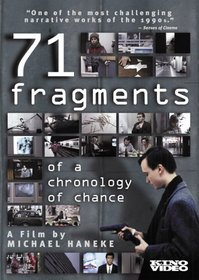| Actors: Gabriel Cosmin Urdes, Lukas Miko, Otto Grünmandl, Anne Bennent, Udo Samel Director: Michael Haneke Creators: Christian Berger, Michael Haneke, Marie Homolkova, Michael Böhme, Paul Bielicki, Veit Heiduschka, Willi Segler Genres: Indie & Art House, Drama, Television Sub-Genres: Indie & Art House, Drama, Television Studio: Kino Video Format: DVD - Color,Widescreen - Closed-captioned,Subtitled DVD Release Date: 05/16/2006 Original Release Date: 10/26/1995 Theatrical Release Date: 10/26/1995 Release Year: 2006 Run Time: 1hr 40min Screens: Color,Widescreen Number of Discs: 1 SwapaDVD Credits: 1 Total Copies: 0 Members Wishing: 4 MPAA Rating: Unrated Languages: German, Romanian Subtitles: English |
Search - 71 Fragments of a Chronology of Chance on DVD
  | 71 Fragments of a Chronology of Chance Actors: Gabriel Cosmin Urdes, Lukas Miko, Otto Grünmandl, Anne Bennent, Udo Samel Director: Michael Haneke Genres: Indie & Art House, Drama, Television UR 2006 1hr 40min German-Austrian director Michael Haneke's experimental feature film, 71 Fragments: A Chronology of Chance, explores the bleak, disjointed lives of several people only to tie them together at the end, during a tragic, viole... more » |
Larger Image |
Movie DetailsSimilar Movies
|
Movie ReviewsMedium Cold Liam Wilshire | Portland, OR | 09/03/2007 (5 out of 5 stars) "This is a work concerned with the social impact of TV, a medium Marshall McLuhan described as "cool," or requiring a lot of investment by the viewer, as compared to cinema. Michael Haneke, though, seems intent on making cinema the "coolest" (in the McLuhanesque sense) medium of all. That is especially evident in this third entry in what he has called his "Glaciation Trilogy," so called because the three films address aspects of "the coldness of the society in which we live." (Haneke)
The movie opens with a title card that gives away the end of the movie. A college student named Max B. is, on December 23, 1993, going to go into a Viennese bank and shoot three people dead, then turn the gun on himself. From there we proceed to the threads of the story, beginning on October 12, 1993. Basically, there are seven main characters. There is Max, the college student; Marian Radu, an ethnic Romanian boy from Bucharest, has come to Austria because he has heard "people are nice to children" there; Tomek, an elderly man, lives an isolated life even though his daughter also lives in Vienna; Inge and Paul Brunner are a childless couple in the process of adopting a daughter; and Hans and Maria are a married couple at wits end, due to the illness of their infant. Three of these will be dead at the end of the film. Two of them will be at the bank because they are habitually there. So, the "chance" of the title really only refers to one character, at least as regards the shootings. The "71 Fragments" are isolated from each other by black-outs. About twenty of these segments prominently feature a television or a monitor. Several others feature them as audio elements, or have them playing out of focus in a portion of the screen. Most broadcasts are news programs, taken from real sources, and demonstrate how news stories are fashioned to show the viewer how to feel about world events. "Cool medium," indeed. Haneke, in an interview found in the "special features," says that he strives to make his films in a way that shows "what is wrong in way that gives you a desire for the alternative." This amounts to almost a manifesto in his body of work, and accounts for the increasingly decentered and sometimes inscrutable quality of his films. Here is a funny game Mr. Haneke plays with anyone, like me, who decides to count the blackouts. There are only sixty-eight of them. Sixty-eight blackouts, but still "71 Fragments." It is a little mystery a bit like the encounter at the end of CACHÉ, in which two people who aren't supposed to know each other have what appears to be a friendly and familiar conversation--one that is inaudible to us. Fade to black, The End. Well, for those who care enough to count, I think the three missing fragments are as found as follows: two additional fragments are embedded in the very clever blackout #43, which begins with Radu telling his story on TV. The third missing fragment occurs at blackout #68, and concludes the film. As with everything Haneke does, this mystery will have different theories, but for what it's worth, there is mine." |





